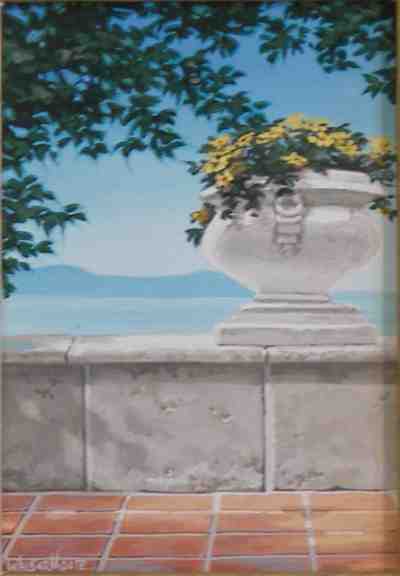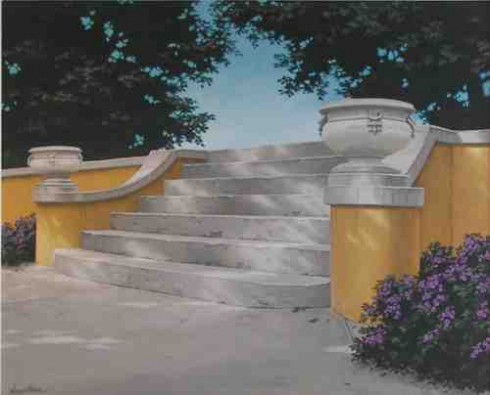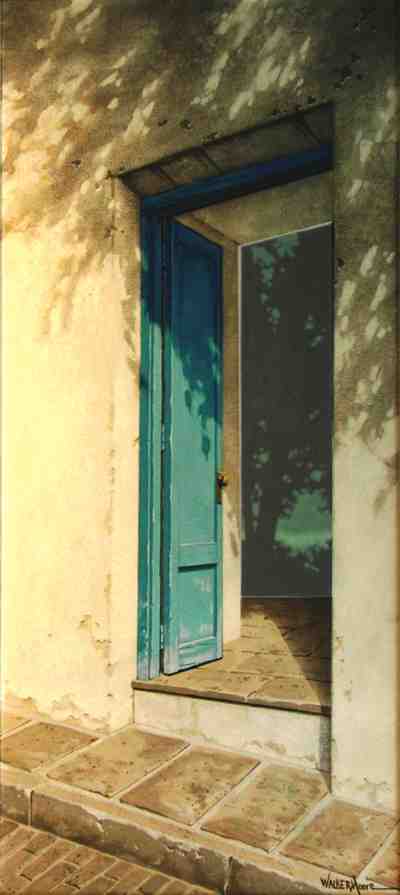Article by Sue Snively
Art – August 2008 – Colorado Central Magazine
GALLERY 150 is a magical place, featuring the work of potters, glass artists, jewelers, clothing designers, painters, and a basket maker. Jerry Scavezze and his wife, Susan Bethany, have owned the gallery for 10 years, and strive to exhibit high quality art in a dazzling variety of mediums.
Many of the exhibitors are local, others are selected from throughout the country. Recently, due to a gallery expansion, the work of three furniture makers was added.
One painting draws the eye no matter where one stands in the gallery. A half-open door leads into a quiet yard, and shadows reveal the waving branches of an unseen tree. An adept blend of bright light, subdued light, and subtle color suggest a world of peace and serenity waits beyond the threshold. It’s intriguing to imagine stepping inside.
The work is called “Hopeful” and is the creation of Arkansas River Valley artist, Walker Moore.

Nearby paintings by Moore are very different, but equally compelling. With their unique use of color, light and shadow, they elicited strong emotional responses from this viewer. This art spoke to me — in a variety of ways.
The artist, Walker Moore, has a secret to tell. He/she is really two painters in one. Roxann Moore and John Walker began painting together in 1981 when he painted a seagull in the corner of one of her seascapes. The idea of working together was born, and it has worked for them ever since.
But paintings with two artists’ names on them were not readily accepted in the art world, and Moore and Walker frequently found themselves turned away from venues where they wanted to exhibit. Thus the name Walker Moore was born and now is the signature on all of their work.

THE MEDIUM THEY USE is a very old, durable, and versatile water medium called casein. As explained by John Walker in a 1980’s edition of The Artist’s magazine, casein is actually a milk by-product that began its artistic career essentially as dried skim milk. Alkalis such as ammonia were added so it would dissolve in water. The alkaline substance also emulsifies various oils to improve the handling. Preservatives to prevent spoilage are added and the pigments are those used in most artist quality paint. Roxann and John say that it is a difficult medium to work with, but its positive aspects make using it worthwhile. Besides the mentioned durability and versatility, casein dries quickly, thus aiding in the process of painting over or reworking an area in the pictures.
The painting relationship between Moore and Walker started cautiously and modestly with the seagull mentioned above. Roxann, who had worked with casein since she was a child, wanted to continue with casein. John, who had been using his incredible sense of values mostly in black and white drawings, agreed to use the medium.
Working together seems natural to them now, but in the beginning it was difficult. Initially they tried to stay in their own area of a painting, with each of them doing about half of every piece. That was a peaceful way of collaborating, but it didn’t work for them.
It was clear that their own egos had to be supplanted by the importance of the painting. They tried painting simultaneously, but found it easier to trade the painting back and forth, each adding to every segment of the picture, instead of doing their own segments. John, who is partially color blind, tends to use brighter colors, where Roxann paints in more subdued hues. What results is something in between.
The two don’t want to call attention to themselves as separate painters, and thus their individual brushstrokes seldom stand out. Yet the texture in their work is so convincing it makes the viewer want to reach out and touch the stucco of a building. Essentially their work blends color, light, shadow, motion and texture to create not her style, nor his style, but rather the style of “Walker Moore” .
In one work, low yellow walls come from each side. A series of concrete steps climb in the shadow of an unseen tree. A bush with purple flowers crowds the stairway, and there’s a column with a huge vase on top. But it’s the blue sky showing behind an arch that draws the eye.
That feeling of looking into the “beyond” and wondering what is there overwhelmed this viewer, and the phrase, “escaping into the wild blue yonder” crept into my mind. This profound painting is called “Majestic.”
Roxann and John think of themselves as painters rather than artists. They make their total living as painters and it is their full-time occupation. Each piece they do is hard work and time-consuming, and yet fulfilling. They start with a line drawing. The next step is to do an underpainting, usually using a warm color, covering all but what they term the opening or the space beyond the open door. After the underpainting, layers are put on by scumbling or the addition of from 6 to 12 layers of thin dry paint. How many layers are used depends on the luminosity they wish to achieve. The more layers they add the closer they get to opaqueness.
They then work on highlighting and shadowing and texturing. The last step is achieving distance so the viewer will look “beyond” the painting. In their work this is frequently achieved by adding the shadow of an unseen tree. In fact that tree shadow as well as the open door and what is beyond, are trademarks of most of their paintings.
BUT THEIR PIECES are definitely not fixed before they start. Instead the paintings evolve as they work, generating creativity and spontaneity. Every time they come back to the work, the painting is different. The notion of what it is is constantly under review. Even though they say a piece is finished when both of them agree that it is done, in their mind, Walker Moore paintings do not stand as art until the viewer enters the picture.
The viewer’s response to their work is what completes their endeavor.

Besides gallery 150, located on First Street in Salida, Walker Moore’s work may be seen in galleries all over the west including New Mexico, Arizona, and Washington state. It is important to them that their work is shown with other high quality pieces, so they choose the galleries they submit to with care. Their work is also in many private collections.
Sue Snively writes about art and much else from Buena Vista.

